Reviews
Is The Blackvue DR900X-2CH Worth it? In Depth Review
Published
4 years agoon
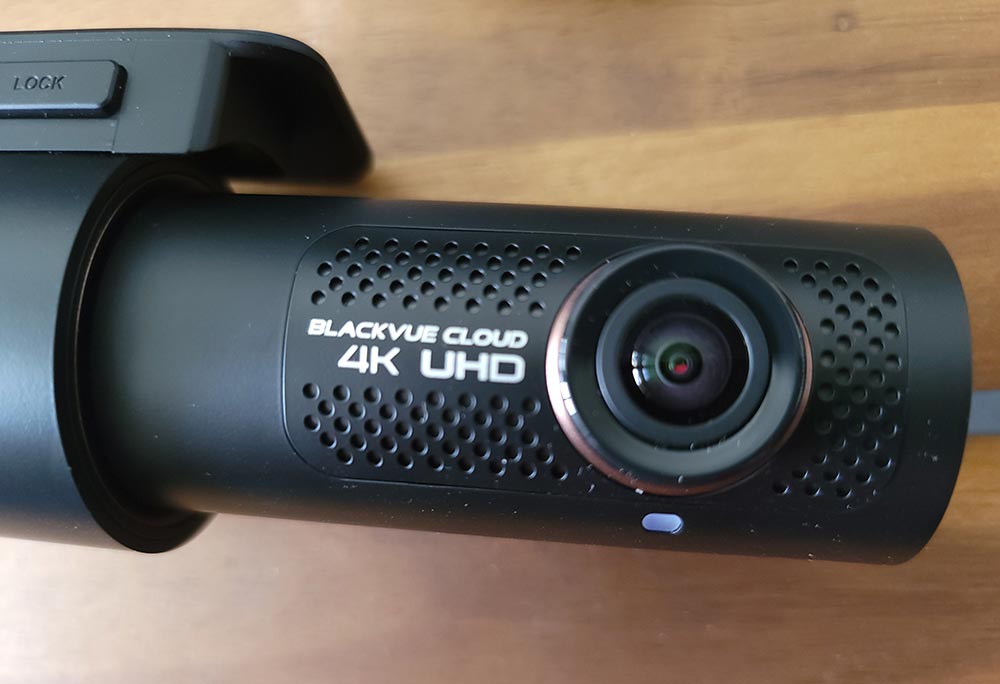
Blackvue, a well-known South Korean manufacturer, debuted their most advanced dashcam in 2020, the DR900X 2CH. This model replaces the previous generation of DR900S and comes loaded with new features. The main selling point being it now has cloud integration built into the unit. So with the proper setup, you can monitor your vehicle 24/7 so long as there’s an internet connection.
Worth reading: See our of the iRoad X10 4K UDH Dashcam
Choosing 1 or 2 channels
If you don’t think you’ll ever need a rear camera, choosing one channel is fine. However, if you ever plan to add a rear camera later, you’ll need to buy the two channels instead. The one-channel model isn’t compatible with a rear camera and is missing the actual port to plug in a rear camera. If you want dual channels and have front and rear cameras, you’ll need to make that decision upfront.
What’s in The Box?
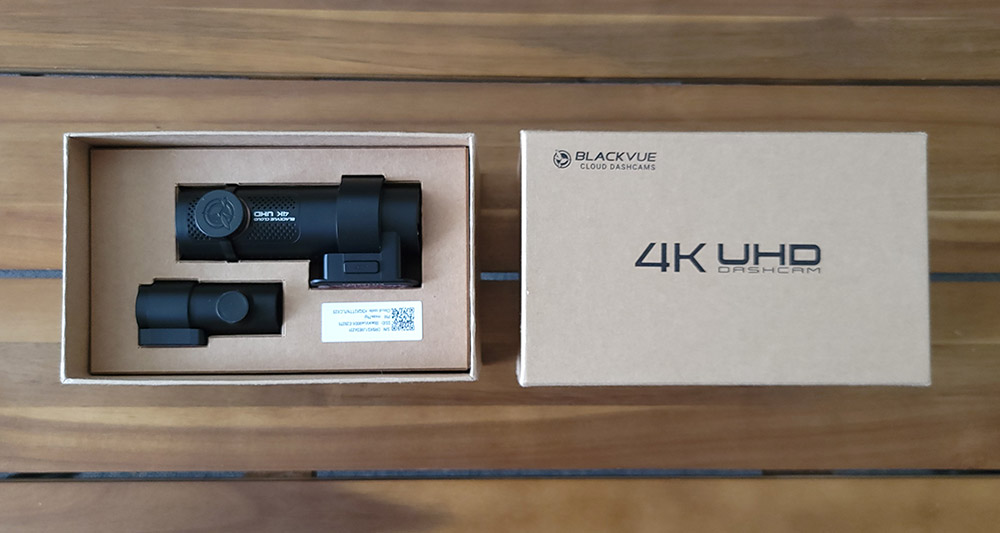
Everything comes in what seems like suitable and compact packaging. Both the front and rear cameras, accessories, and wires are well packaged, and there’s no unnecessary packaging. We appreciate it when companies are environmentally conscious.
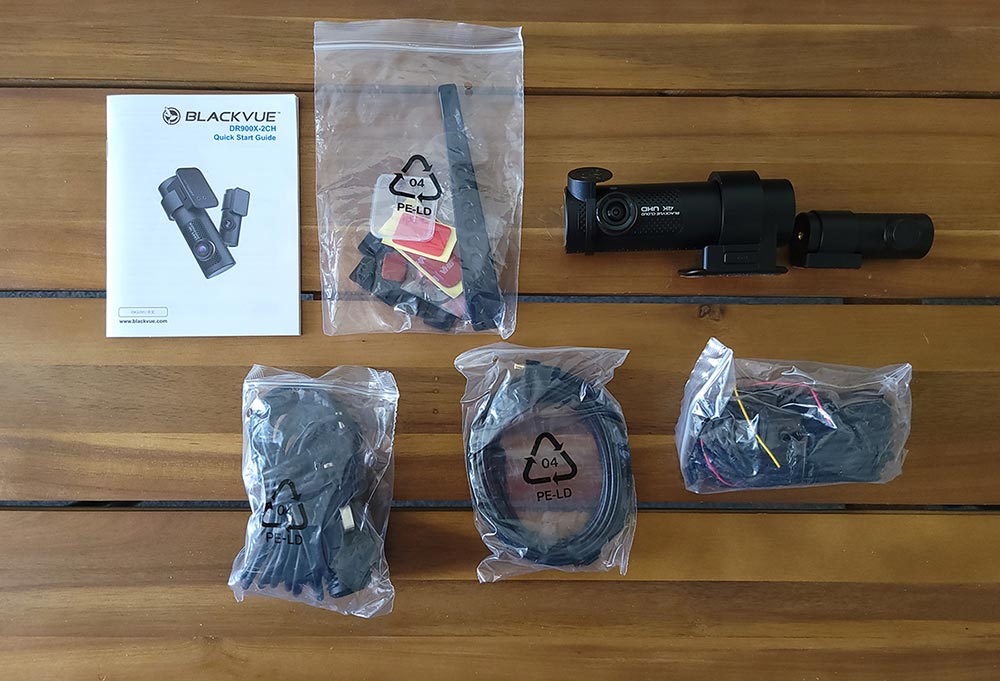
Inside the box is everything you’d expect and some more. There’s an abundance of cables and wires that you’ll need later for installation. One thing I noticed that Blackvue does that other manufacturer’s neglect is included installation tools. The pry tool was a lifesaver for me when installing, as it helped prevent damages that I otherwise would’ve had if I had used whatever tools I had.
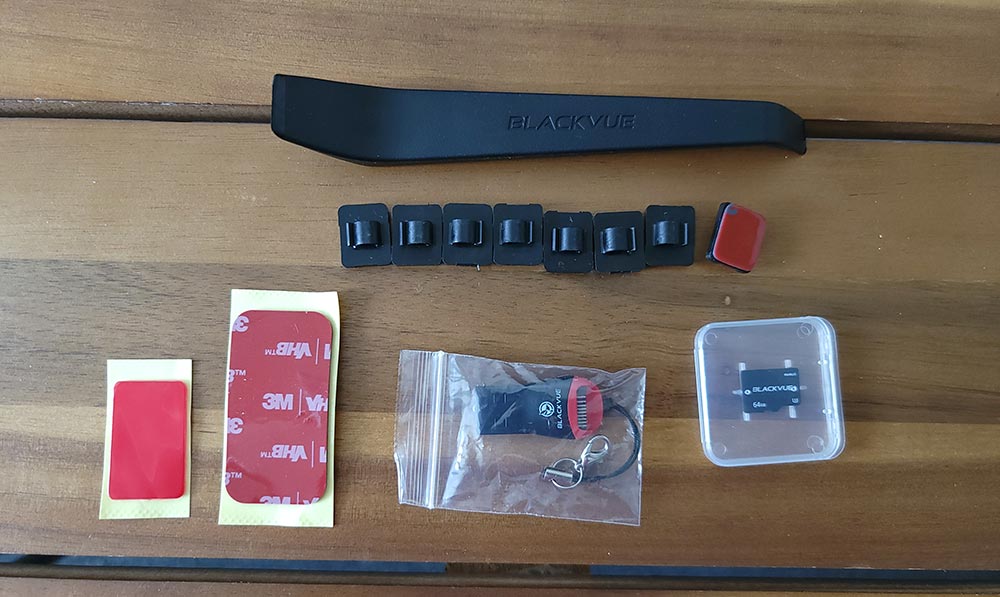
Installation
If this is your first time installing a dashcam, I recommend checking out the following Youtubers. They’ve done a great job walking through the installation process, especially the hardwiring bit.
Some things to keep in mind when installing…
- Download the app first: Make sure you set the dashcam with the app first. Then test the mount in different positions and see how it appears on your phone. The included 3M tape sticks once you place it down, so you won’t be able to make any adjustments. Make sure to try different placements and adjust accordingly before permanently sticking the camera in place.
- Clean your windshield: The adhesive is strong but will slip off if the glass is dirty. Use a glass cleaner or rubbing alcohol to give the area a good wipe before mounting.
- Front & Rear end of the wire: The wire that connects the front and rear camera have a definite front and back end that’s labeled. Make sure you set up the front camera first, so you have it right.
- Accessibility to ports: When installing, ensure that all your ports and the microSD slot are accessible. Some vehicles (like mine) have a large center console on the windshield that can block access to these ports.
- Install the CM100 LTE Module simultaneously: If you plan to use the CM100 LTE module for WIFI connectivity, make sure to install it at the same time. This way, you’ll only need to cable-manage once.
- Use the pry tool: Use the included pry tool. Don’t try to use a screwdriver or anything with sharp edges. You could damage your interior or the wires.
Hardwiring
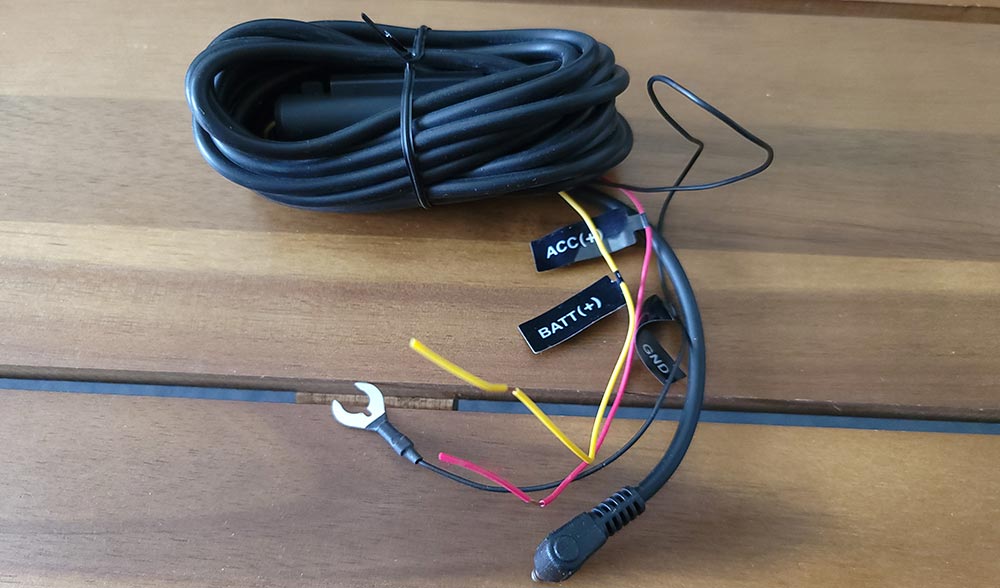
Previous models needed to have the Power Magic Pro device keep the dashcam running when the engine is off. Thankfully, the DR900X has a built-in low-voltage cutoff and comes with the hardwiring tools to connect the unit directly to your car.
I don’t see many reasons why you’d use the included cigarette lighter socket adapter. However, if you’re spending this much on a dashcam, you may also spend the time to install it right to take advantage of all the features that come with it. Many of the idle parking and live-view features require the unit to be hardwired, so keep that in mind.
Front Camera

The DR900X’s 8mp CMOS sensor captures actual 4K UDH footages at 30fps. I say “actual” because I’ve tested other 4K dashcams that claim to record in 4K, but it’s not genuine 4K. Their smaller sensor records the footage at a lower resolution and then upscale to 4K. The front camera has a viewing angle of 162 degrees, which is more than enough real estate to see everything ahead and even a glimpse of the sides.
Video quality is excellent if this is your first dashcam or an upgrade from a lesser model. The resolution and pixel density produce sharp images at a distance, but it still lags behind VIOFO and Thinkware’s comparable dashcams. This is surprising given that Blackvue was the first manufacturer to roll out 4K on their devices. Blackvue’s devices have a competitive edge before, and I wish they’d kept improving their image quality.
Rear Camera
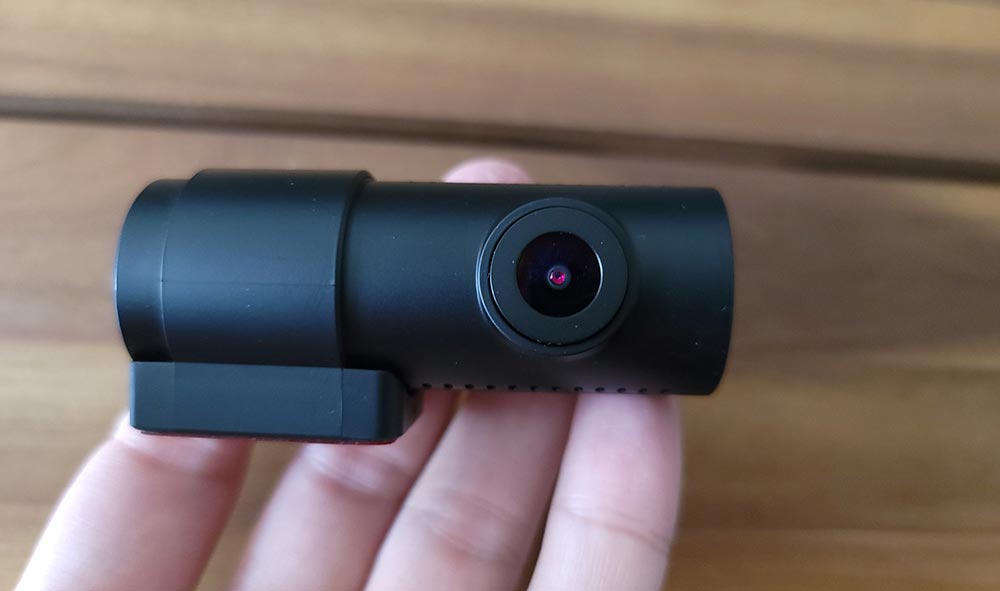
The rear camera equips a Sony STARVIS CMOS sensor capable of shooting full HD 1080P at 30fps. It’s a reliable rear setup that will give exceptional video quality day or night. The 139-degree viewing angle is standard and gets the job done. Video quality is clear, and the 1080p resolution can make out license plates within about 15-20 feet during daylight hours with decent lighting.
MicroSD Capacity
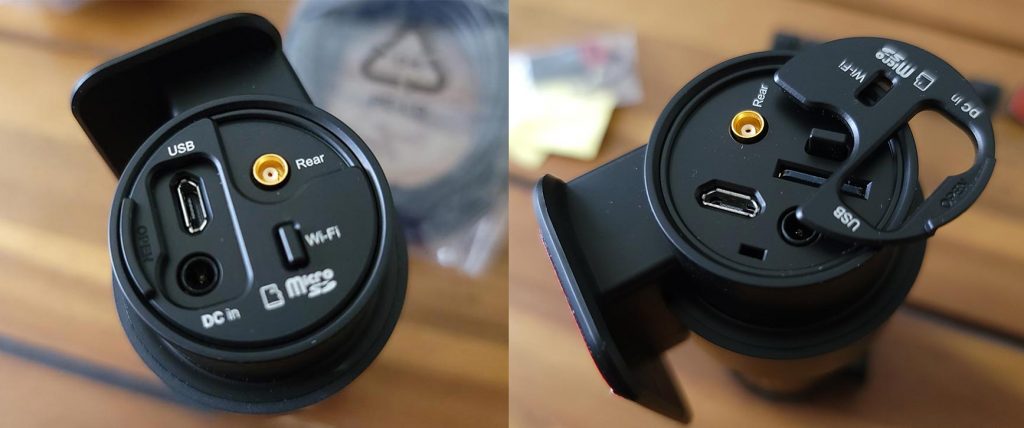
When purchasing, you can choose from 32GB, 64GB, 128GB, or 256GB. These are NOT onboard storage, but instead of the size of microSD, they’ll ship with the unit. I would go with the 32GB and then purchase either the 128GB or 256GB microSD card separately to save some money.
The expandable storage can up to 256GB, which will give you about 21 hours of recording. That should be plenty for most use cases, including parking mode.
The microSD port is hidden behind a snap-on cover on the side of the front camera. This can be tricky and even frustrating if you frequently take your microSD card out to upload footage. I was not too fond of this because I find myself having to take the entire front camera off the mount to get the microSD card out. Hopefully, for the next iteration, Blackvue makes the microSD port more accessible.
Video Storage
Videos are saved on the microSD card and can also be uploaded to the cloud. Videos are optimized, and the file size is smaller than you’d expect, given it’s recording in full 4K UDH. This certainly helps to make the most out of your 256GB microSD capacity. Others have reported reduced video quality due to this optimization. However, it’s still lightyears better than 2K quality upscaled to 4K.
Cloud Integration
This is likely one of the main reasons you’re considering the DR900X, so let’s go over it in detail. There are a few requirements that you need to be aware of before buying this device.
Requirements for Cloud Integration
- Hardwire: You’ll need to use the hardwiring kit. A cigarette socket won’t do.
- CM100 LTE Module: You’ll need to purchase the $169 CM100 LTE module separately.
- Data plan: You’ll also need a sim card with a data plan to provide WIFI for the car.
- Blackvue Cloud subscription: Finally, you’ll need to have a subscription to Blackvue Cloud. Luckily, a free plan gives you up to 10 minutes of live view per day and 100 playbacks per month. If you need unlimited live view and playback, you can upgrade to the Smart Plan for $11.99/m.
Overall, this may seem daunting to first-time users, but it’s an essential requirement to get your vehicle set up for cloud recording. Blackvue isn’t making you do anything unnecessary.
Blackvue Cloud’s Subscription
Blackvue currently offers the best cloud-integrated dashcam on the market. Almost everything happens instantly. The real-time notifications are responsive. The live view also gives an actual live view with reasonably low latency, which is impressive. And whenever there are firmware updates, you can update directly from your phone.
Other manufacturers will try to make more money off their customers by offering a flimsy free plan lacking essential features. Then, they’ll force you to upgrade to a paid subscription at some point. As a consumer, we don’t appreciate these bait and switch schemes.
Fortunately, Blackvue’s free plan is also generous and gives plenty of value as-is. All the essentials you’ll need are included in the Free plan, including 5GB of storage (Smart plan also has 5GB). So you don’t need to upgrade unless you have a strong need for unlimited viewing, unlimited playback, and up to 365-day storage.
Robust App
Unlike the VIOFO, the Blackvue doesn’t have a screen. Instead, you’ll need to make all the adjustments via a paired Android/iOS app. Generally, these apps tend to be an afterthought and riddled with bugs (looking at you, Thinkware). Blackvue’s App, although barebone looking, is a breeze to use.
The branding was a bit sketchy since it didn’t look like a native app from the manufacturer. But once downloaded and connected, it works like a charm—no crashes, glitches, or features that don’t work.
When using a dashcam with an app interface, it’s important that the App works flawlessly and get constant updates. Otherwise, you’re stuck with a unit with tons of capabilities but no user interface to take advantage of them.
One thing I wish Blackvue had done was making the App look more polished and professional. Currently, iRoad dashcams have the best-looking and most robust App interface. Blackvue’s App experience is solid but only comes second.
Heat Tolerance
This is an area that the DR900X outshines its predecessor. The DR900S could only tolerate a temperature range from -20C (-4F) to 70C (158F). Meanwhile, the DR900X can withstand extremes from -20C (-4F) up to 80C (176F). This level of heat resistance puts the Blackvue on a comparable level of reliability as the iRoad X10 dashcam.
Philadelphia didn’t have the weather extremities needed to put this unit to the test, so we’ll have to take the manufacturer’s word for it.
Verdict
The Blackvue DR900X is one of the best dash cams you can buy in 2021. It has everything from 4k Resolution, Cloud-integration, high-temperature tolerance, a full suite of security and parked features, to an intuitive iOS/Android app. At $449, it’s certainly a premium, but you will get premium features for the price. Owner’s Mag highly recommends the Blackvue DR900X.

Looking to get a boost on PR? Help OM out by signing up for Prowly with this link.
SEO work involves various elements, and understanding how each one functions is crucial for success. While many of the best all-in-one SEO tools come with a hefty price tag and require a monthly subscription, they are often only accessible to larger companies that can justify the expense. For smaller businesses, investing in an expensive SEO package can be challenging.
That’s why we’ve gathered a list of the best free SEO tools available today, including Prowly, which can help you enhance your search engine optimization efforts without breaking the bank. Start optimizing your website today by exploring the most effective free tools you can use right away.
Getting started with Prowly
As mentioned in my Demio review, the convenience of SaaS allows you to quickly use software through your browser. Signing up for Prowly is as simple as clicking the “Try it for free” button in the upper right corner of the site.
Prowly pricing
Prowly offers a 7-day free trial so users can try before they buy. Beyond that, they offer an Essential plan for smaller-scale users and a Professional plan for agencies.
The most basic form of the Essential plan starts at $119/mo, while the Professional plan starts at $189/mo. You can add features to your plan—including media monitoring and access to Prowly’s media contact database—for an additional cost.
What can Prowly do?
Remember that thing I said about customer experience? Prowly clearly got the memo, because as soon as you sign up, they invite you to schedule a meeting with them. This shows a real dedication to customer support that you don’t see every day. But since I’m only trying out the product for a review, I opted out.
Dashboard
Prowly’s dashboard maintains a simple, inviting design. This is especially helpful since the choices you’re presented with are a bit overwhelming. As someone with limited PR experience, the very idea of starting a press release feels daunting.
Still, front and center on your home page is a simple timeline you can use to wrap your head around Prowly. It breaks it down into four easy steps: creating press releases, finding media contacts, setting up a newsroom, and sending email pitches.
Let’s take a look at each of those features.
Making press releases with Prowly
Prowly has a wide array of options for crafting press releases. You can upload a .docx file, start from scratch, or choose from various templates like event announcements and new hires.
These templates are designed to get your mind jogging, rather than filling in the blanks Mad Libs-style. The text editor is fairly simple with limited font and formatting options. Still, you generally don’t want to get too wild with a press release.
Make sure not to hit “Publish” before it’s fully done, as you can’t go back and change it.
Finding media contacts
Like with the press release tool, there are a few ways to get started with finding media contacts. You can import or manually add your existing contact list, but you can also peruse Prowly’s extensive database.
Media contacts range from entertainment to politics, business to beauty. They include some of the biggest names and publications in journalism. Just keep in mind, you’ll have to buy an upgraded plan to get access to the contact database.
If you just want to get started, importing existing contacts makes for much less hassle. At the bare minimum, you can put in a few emails and move on to the next step…
Creating a Prowly newsroom
A Prowly newsroom is a custom webpage designed to compile your brand’s content, press releases, and other news. While it’s less customizable than your own website, it allows your media contacts to easily find all of your content in one place.
This can be a useful tool for shaping your narrative. You can organize your PR output into tabs and categories, and customize the design to suit your brand. Still, I’d argue you could probably do better making a media tab on your own website.
Sending an email pitch
Finally, the main event. You’ve made your press release, your newsroom, and compiled all your contacts. Time to pitch!
You can choose to select certain recipients or email your whole contact list. Prowly gives you the tools you need to create an engaging email, with a dozen professional fonts and a bevy of text options.
Where the newsroom layout is fairly one-size-fits-all, you have much more customization options with your pitches. This makes sense since the email pitch is the thing that gets your media contacts hooked.
You can add images, tables, files, and links to your pitch, as well as additional press releases and a call-to-action button.
Like many CRMs, Prowly includes personalization tokens. These are variable text elements that can be tailored to specific recipients. For example, you can add a Greeting token that inputs different greetings for different recipients. Then, by applying values to people in your contact list, you can ensure they each get a greeting that’s specific to them.
After that, simply review your email and send it off! Prowly recommends you sort your emails into campaigns, which makes it easier to keep track of different releases and review their success.
Monitoring and reports
One of Prowly’s more impressive features is its media monitoring dashboard. Above and beyond keyword research, this tool includes widgets to track sentiment, reach, domain authority, and much more.
While easily sending out and keeping track of pitches is great, this tool makes Prowly worth your while. Every tool at your disposal from WordPress to Google Ads has some flavor of monitoring, but this is the rare dashboard that synthesizes every metric a PR agency needs. Just as important, the custom widgets also let you exclude the data you don’t need.
Prowly is teasing a forthcoming feature that lets you view stats on your campaigns through PR reports. As advertised, these reports go above and beyond, compiling data to show the complete picture of your PR work.
As it currently stands, the lack of specific stats on a campaign’s success is one area where Prowly could improve. For PR workers, the ability to compile deliverables makes a big difference, so I hope this feature gets rolled out sooner rather than later.
Is Prowly worth it?
For companies, agencies, and entrepreneurs working in PR, Prowly (wait a sec… PR owly!) promises an easier way. It highlights the ability to easily create, release, and track press releases online.
Prowly’s most impressive features are its media monitoring tools and contact database. I was somewhat less impressed with the press release tools themselves, but I acknowledge the utility of having a simple online dashboard to keep track of them.
Prowly is definitely a strong PR tool; the contacts and monitoring tools alone are enough to make it worthwhile. Still, it faces a common SaaS problem: how much ownership will you give up for convenience?
For that purpose, I like the fact that Prowly also lets you import releases, contact lists, and more. You can choose whether you want a convenient experience or a custom one, which is an attitude more SaaS programs should have.
Prowly is sort of the Canva of PR software. It’s shiny, accessible, and gets the job done, with a few impressive tools that put it over the top. But if you want something fully custom, you’ll still have to make it yourself.
Final rating: 7.9/10 ✅
Like what you see? Sign up for Prowly today.
Business
Bit.ai Review for Businesses in 2025: Is It Still Worth It?
Published
1 month agoon
July 23, 2025
When you’re collaborating on documents with other writers or co-workers, how do you keep everyone on the same page?
Truth be told, for most of you, the answer is probably Google Docs. It’s quick, efficient, and easy to share. But what if there was a better way?
Bit.ai professes to be “the world’s most powerful workplace and document collaboration platform.” In this Bit.ai review, we’ll put that claim to the test.
Bit.ai Review: What is Bit.ai?
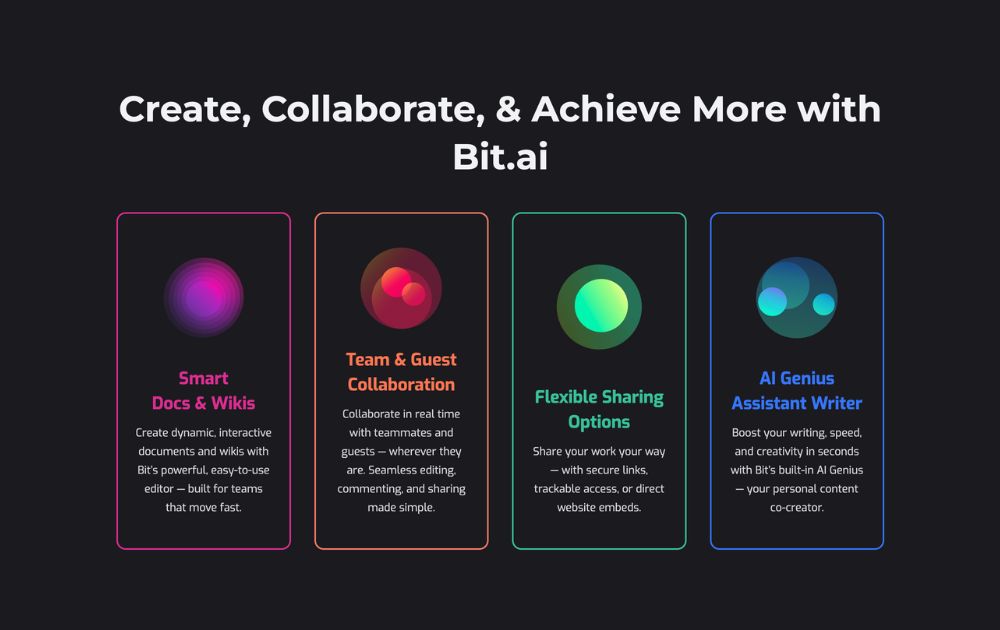
Co-founded by Raj and Saje Sandhu, Bit.ai has been offering document collaboration to companies like Canon and Harvard University since 2007. The company employs a global team with headquarters in San Francisco.
What does Bit.ai offer?
Bit.ai has grown into a smart documentation and knowledge management platform tailored to businesses of all sizes.

With the release of Bit 3.0 and the built-in AI Genius Writer in time for other tech players’ version of AI boom, the tool is now as much about content intelligence as it is about collaboration.
Features include:
- Collaborative document editor with AI assistance
- Smart content library with internal linking
- 100+ file type support and embed options
- AI-powered writing and content structuring
- Automated themes, templates, and formatting
- Cloud integrations (Google Drive, OneDrive, Box, etc.)
- Document tracking and engagement insights
- Branded, interactive documents
- Customizable workspaces and guest access
- SSO, 2FA, and admin-level security controls
We’ll explore some of the key features in the next section.
How much does Bit.ai cost?

Individual users and Bit.ai offers a flexible pricing model suited for individuals, teams, and growing businesses. Here’s a breakdown of the current subscription plans (based on annual billing):
- Free Plan – $0/user/month. Includes up to 10 documents per user, 5-user limit, single document import, access to integrations and collaborative workspaces. Exporting, version history, and AI tools are not included.
- Pro Plan – $8/user/month (billed annually). Offers unlimited documents and users, bulk document import/export, access to version history, and 20,000 AI Genius Writer words (with add-on). Also includes advanced permissions and external sharing features.
- Business Plan – $15/user/month (billed annually). Includes everything in Pro plus more advanced collaboration features like guest access, embed options, and extended AI capabilities. Also includes top-tier permissions and document management features.
Monthly billing is available at higher rates. Bit.ai also provides custom enterprise plans and continues to offer discounted rates for education, startups, and nonprofits.
Bit.ai Review: How to sign up
Getting started with Bit.ai is as simple as inputting your email and receiving a six-digit verification code.
After that, you’re asked to fill out information like your name, your job title, and your department at your company, as well as create a password. Right off the bat, Bit puts businesses first, setting itself apart from Google Docs before you even log in.
But it doesn’t stop there. When you sign up, you create a profile for your whole company, getting a custom subdomain for your team to access your library.
And there you have it! Once you’re logged in, you have the option to see a tutorial. If you want to upgrade to a paid plan, use the handy “Upgrade” button in the lower left corner of your dashboard.
Bit.ai Review: Features
The Bit.ai web app includes tabs for your dashboard and a list of all your workspaces.
The Bit.ai dashboard

Your Bit.ai homepage allows you to view recent activity, featured templates, tutorials and updates, as well as see how close you are to your document limit if you’re a free user.
Free users get access to most core collaboration features but not premium functions like AI, exporting, or advanced version tracking.
You can open documents directly from the dashboard, but only using a featured template or a recently-opened one. To create something from scratch, you’ll have to head over to Workspaces.
The Workspaces tab

First thing’s first: create a workspace. Workspaces are where your documents are created, saved, and shared. Once you’ve made one, you can create a new document, either by using a template, importing an existing document, or starting from scratch.
Creating a document with Bit.ai

When you create a new document in Bit.ai, you’re taken to a bare-bones writing editor similar to Notion. In addition, AI Genius Writer is now integrated into the editor to assist with outlines, rewriting, or prompts. I always find it hard to start writing when you don’t have anything visual to guide you, but once you get the hang of it, it’s fairly intuitive.
I think the reason for this no-frills approach is to make it easier to take meeting notes and write down quick thoughts about a project. For more in-depth functions, however, you can highlight your text after you’ve written it to change the formatting. There’s also a + icon next to your cursor that lets you add links, embeds, files, code blocks, and more.
One neat feature of this text editor is the ability to link directly to other documents and content in your Bit.ai library. It makes it much easier to cross-reference documents than it is in Google Docs, Word, Notes, etc., another great benefit for businesses.

There’s no need to save your documents in Bit.ai—that happens automatically. When you’re done, however, you can share it with collaborators and others, lock it to prevent further edits, change its associated colors, view stats and version history. Note: exporting, version history, and AI writing are reserved for Pro and Business plans.
Bit.ai writing templates

Bit offers a huge range of templates, with themes geared towards managers, marketers, designers, educators, and much more. Some of these are designed to function as static documents, such as thesis papers. Others can be hubs for entire business processes, like the video production template.
After trying out a few of these templates, they’re great at showing off all of Bit.ai’s functionality, but they’re useful even if you don’t use Bit for everything. They offer great templates for outlining your processes, making it easier to set a roadmap and including things you might not have thought of.
Importing documents into Bit.ai
While Bit.ai professes to support a massive range of file types, their import menu is a little peculiar. You can choose to import from “Word” (which just allows you to import .docx files from your computer), from a number of cloud-based sources, or Markdown, .txt, and .pdf files.
The strange thing is, you can’t click on “Word” and then upload a .txt file, nor can you click on “PDF” and upload a Word doc. I have no idea why it’s formatted like this, but it made my upload attempts very confusing.
Not to mention, formatting isn’t included when you upload, and the first two uncommon file types I tried (Pages and Final Draft) were both incompatible.
As of 2025, Bit.ai also includes AI Genius Writer in its paid plans—an AI assistant built into the editor that helps generate content, rewrite sections, and build outlines based on your input.”
Bit.ai Review: Final thoughts
So, how does Bit.ai live up to its thesis statement? Is it really “the world’s most powerful document collaboration platform”?
It may not be the most powerful, but it’s certainly grown into one of the smartest options for teams and businesses. While it’s still not a traditional writing tool—you won’t get full font customization or a rich formatting toolbar—it now offers much more under the hood.
With features like AI Genius Writer, smart internal linking, advanced templates, and built-in document analytics, Bit.ai shines as a modern content hub for collaboration, documentation, and knowledge management.
The platform still has room to improve when it comes to document organization and formatting flexibility, but it’s made impressive strides since its earlier versions.
Final grade: 8/10
Reviews
Demio SaaS 2025 Review: Features, Pricing, Pros & Cons
Published
2 months agoon
July 10, 2025
Interested in signing up for Demio? You can support us by getting started with this link.
I kind of hate the word “webinar.”
I’m not alone, either. You can find it in several lists of the English language’s biggest travesties. It’s a holdover from the heyday of lame Web 2.0 portmanteaus, alongside “webisode,” “netizen,” and “listicle.”
However you feel about the word, the webinar itself is anything but dated. The more work moves online, the more vital webinars become for drawing new clients (and keeping the old ones).
Yet, despite their importance, many platforms still haven’t nailed the experience. Some are clunky, others unreliable.
In this updated Demio SaaS review, we take another look at the browser-based webinar tool by Banzai to see if it still strikes the right balance between simplicity and functionality in 2025. Can Demio stay ahead of the curve—or is it time to move on?
Let’s find out.
What is Demio?
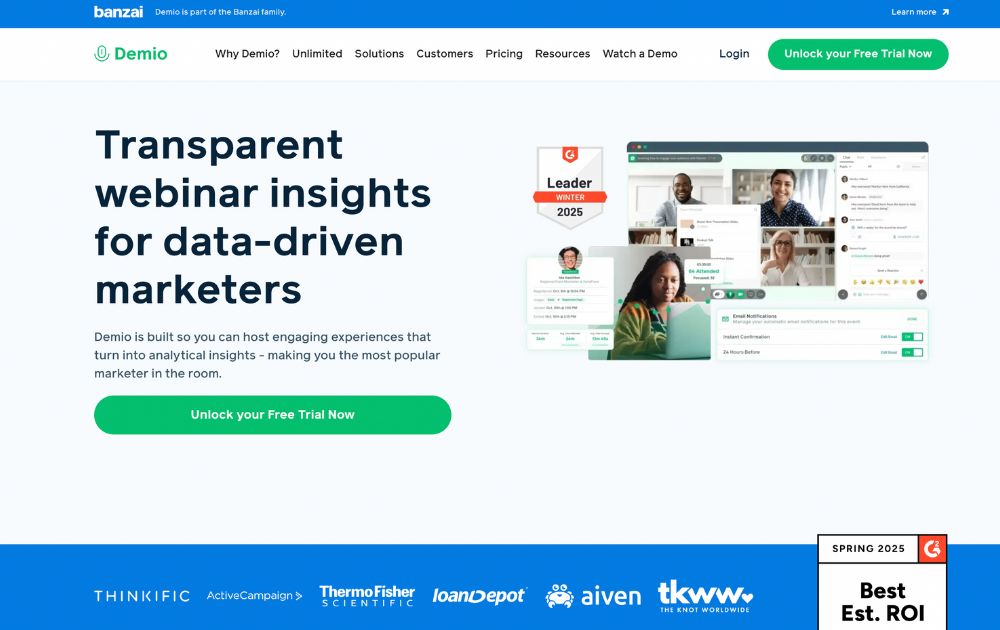
Demio is a browser-based webinar platform designed to make hosting and attending online events as frictionless as possible. Founded in 2014 and now part of the Banzai ecosystem, it was built in response to the clunky, download-heavy webinar tools that dominated the early 2010s.
As this Demio SaaS review shows, that original mission still holds up in 2025. While the pandemic era pushed dozens of companies to improve their virtual tools, many platforms still require attendees to install software or jump through technical hoops just to join a session.
Demio’s solution? Keep it in the browser. No downloads. No plugins. Just clean, streamlined webinar tech that anyone can use right away.
It’s positioned squarely in the SaaS space, with subscription plans that scale from solo creators to enterprise teams. And while it’s optimized for marketing and lead generation, the platform’s ease of use makes it appealing across industries.
Looking for other video communication tools? Check out our Loom review.
Getting started with Demio: Free Trial and Pricing
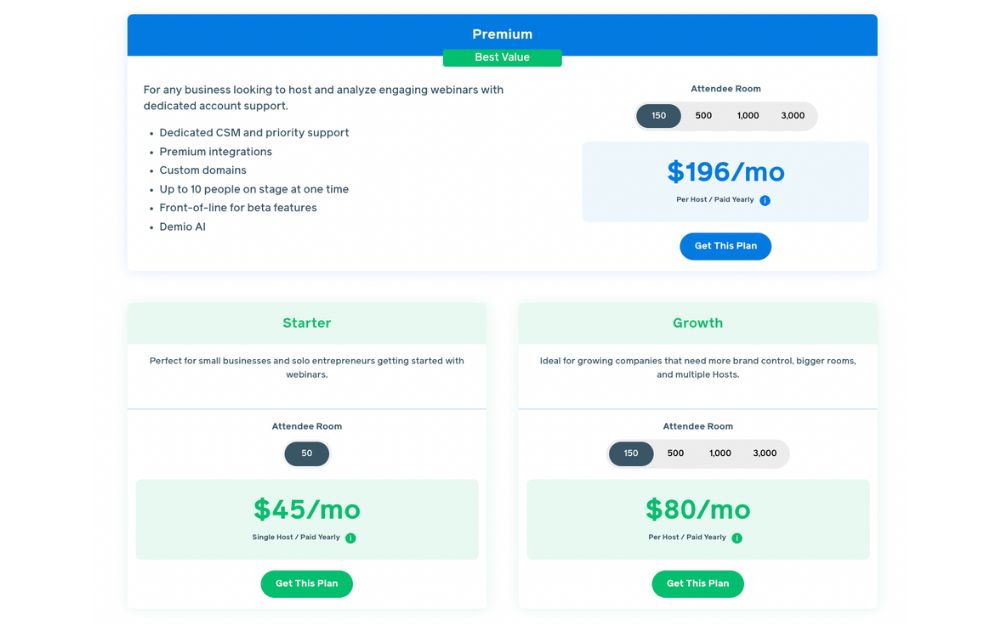
No Demio SaaS review will be complete without the pricing tier. To sign up for a 14-day free trial, just create an account, and you’re ready to explore the platform.
When you’re ready to upgrade, Demio offers three main plans tailored to different business needs:
- Starter – $45/month per host (paid yearly). Perfect for small businesses and solo entrepreneurs getting started with webinars. This tier is for one host for up to 50 attendees. It also comes with core features to launch live webinars easily.
- Growth – $80/month per host (paid yearly). Ideal for growing companies that need more flexibility and brand control. This tier accommodates multiple hosts, with attendee rooms from 150 up to 3,000. This plan also comes with custom branding and enhanced integrations, and reporting.
- Premium – $196/month per host (paid yearly). Designed for larger teams and enterprise use. This tier comes with dedicated CSM and priority support, premium integrations and custom domains, Demio AI, and access to beta features. With this plan, you can have up to 10 people on stage, with attendee rooms of 150, 500, 1,000, or 3,000.
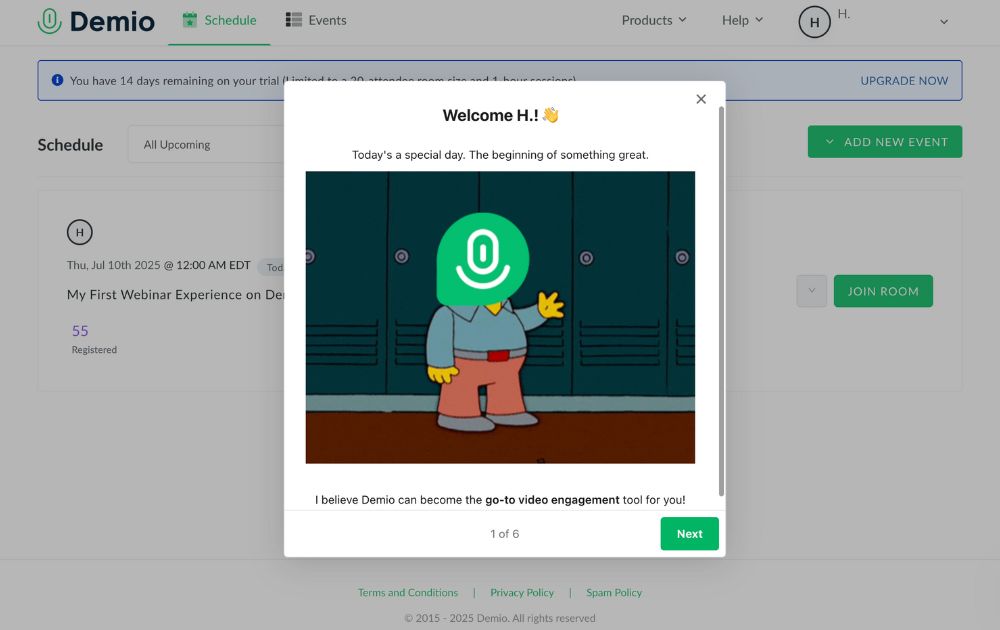
Demio’s free trial requires no commitment or credit card details. Just sign up, fill out a brief survey on how you plan to use the app, and you’re golden.
Demio Features
Demio keeps things simple without skimping on functionality. Once you’re signed in, you’re welcomed by a clean, intuitive dashboard that puts your upcoming events front and center.
Here’s a breakdown of the core features that make Demio a standout in the crowded webinar space:
Dashboard
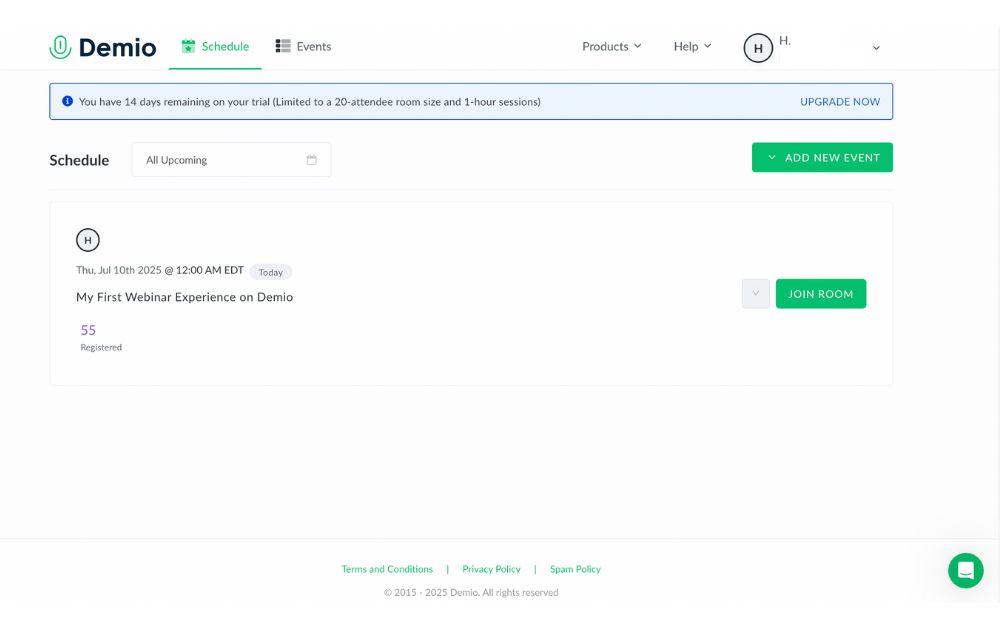
Demio’s dashboard is built for clarity. You can quickly scroll through upcoming sessions, monitor your events, and navigate between tabs like Schedule and Events. It’s functional, but still has room to improve,especially when switching between creating and managing events. A unified view would make it even smoother.
Events
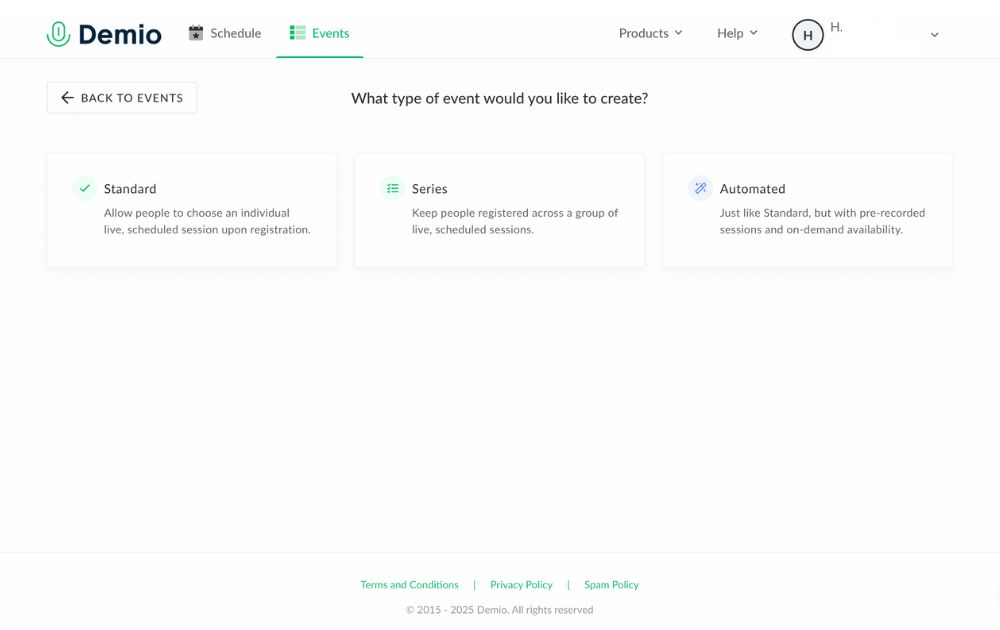
Demio lets you create three types of events, each tailored to different use cases:
- Standard Events – Traditional live webinars where attendees register for a single session at a specific time.
- Series Events – Great for multi-part webinars or training sessions. When users register for one, they’re automatically signed up for the entire series.
- Automated Events – Pre-recorded sessions that run on autopilot. Perfect for lead nurturing or delivering evergreen content without going live.
Automated events continue to be one of Demio’s strongest features, letting you scale your content while staying hands-off.
Customization
Before your webinar goes live, the Customize tab lets you tweak everything from registration forms to event visuals. You can upload slide decks, create interactive polls, set up handouts, and even brand your webinar pages to match your company’s look.
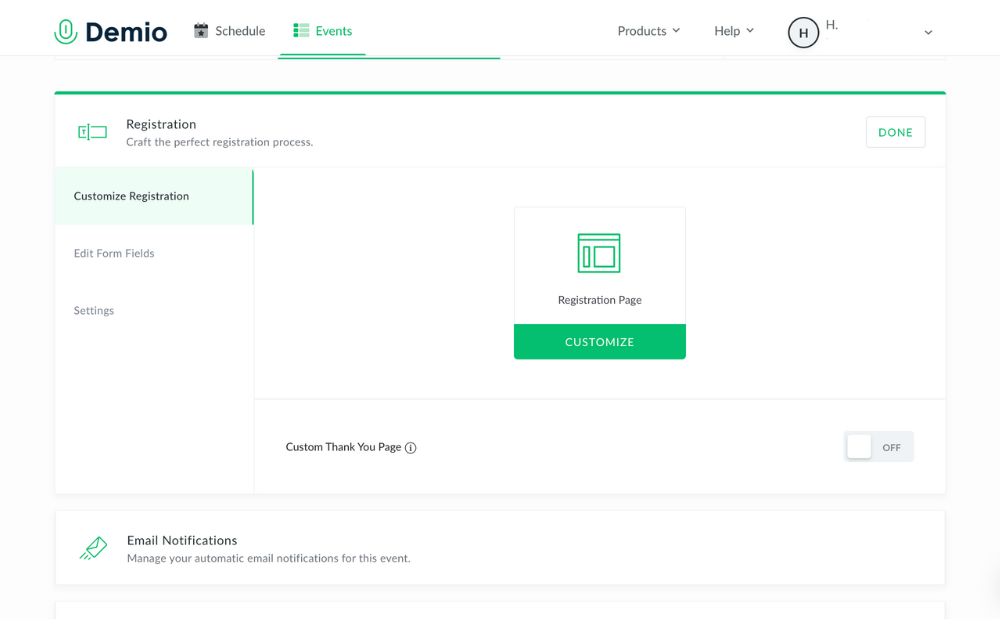
For Growth and Premium users, custom domains and branding take things even further—ideal for marketing teams or agencies.
Once you’re ready to get started, you can join your session in the Schedule tab. The layout is familiar, with speakers’ video taking up the left and center while the chat tab takes up the right side.
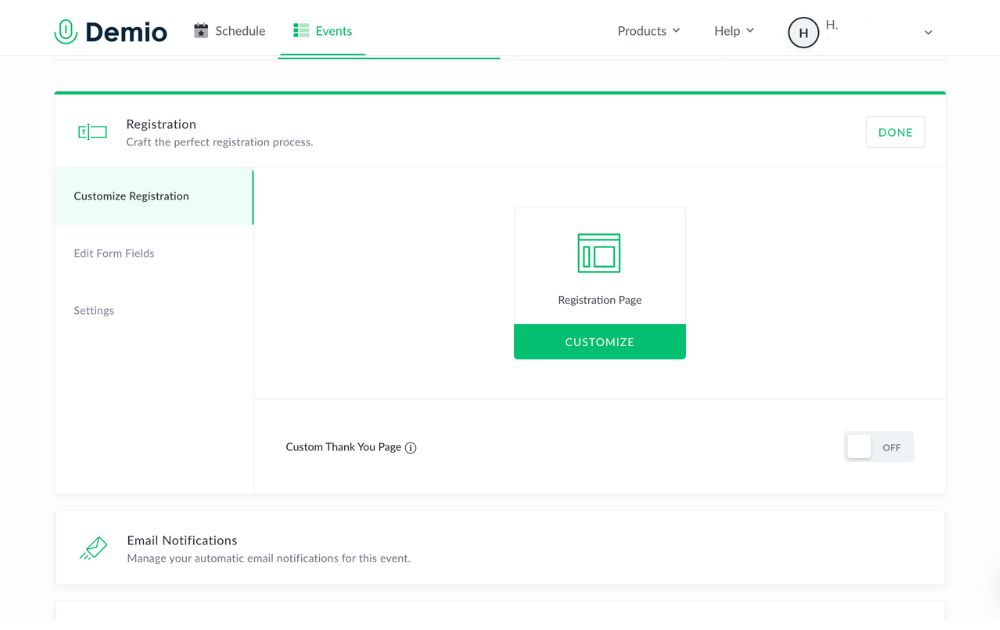
Only one person can be “on stage” at a time, but you can also add and access materials like slides and videos with the middle button on the bottom toolbar. Meanwhile, the + icon next to the chat box lets users access polls, links, and handouts.
Reports
After your session ends, head to the Activity tab to access attendance reports. You’ll see who registered, who actually attended, how long they stayed, and what they engaged with during the session.
Downloadable CSV files make it easy to follow up with participants or segment your leads—an especially useful feature for marketers.
While the data is useful, the reporting could be more advanced (think engagement heatmaps or behavioral trends). Hopefully, that’s in Demio’s roadmap for the near future.
Integrations
I’d honestly like to see a little more variety from Demio’s integrations. On the one hand, their tilt towards martech integrations makes sense. Webinars are generally used for marketing, and being able to connect with Keap, Mailchimp, or your CRM of choice has obvious benefits.
Still, I think there’s a lot more potential to be had with connecting different software to a video conferencing tool. Translators, editing tools, OBS… the sky’s the limit.
Perhaps the most useful integration is with Zapier. Their micro-integrations let you connect to PayPal, Gmail, Slack, and more.
Conclusion: Is Demio worth it?
If you’re seeking a platform to create engaging webinars, Demio is a great place to look. It’s as intuitive as they come, with a number of unique features that set it apart from the competition. Even among browser-based video tools, the fact that it works on any browser puts it ahead.
As of now, Demio is completely focused on webinars. It’s a leader in that market, so they’re clearly doing something right. Where it disappoints, however, is where it feels too laser-guided towards marketing. By just slightly expanding a few features (integrations, reports, in-call elements), I think Demio’s potential could be that much greater.
PROS
- No-download, browser-based platform
- Quick, user-friendly setup
- Supports live, automated, and series events
- Clean, customizable interface
- Great for marketing and lead generation
- Solid integrations with CRMs and email platforms
- Zapier access unlocks thousands of app connections
- Custom branding and domains (Growth & Premium plans)
- Strong customer support and onboarding
- Scalable plans for teams of any size
CONS
- Limited native integrations outside of marketing tools
- Reporting could be more robust (e.g., engagement insights, AI summaries)
- Dashboard navigation could be more streamlined
- Higher-tier pricing may be steep for very small teams
Overall rating: 8.9/10
Ready to give Demio a try? Sign up here.
Frequently Asked Questions
Is demio.com safe?
Yes, demio.com is a secure and reputable site owned by Banzai, using encryption and standard security protocols to protect user data and webinar content.
Is Demio like Zoom?
Demio and Zoom both support video communication, but Demio is specifically built for webinars and marketing events, while Zoom is designed primarily for meetings and general video conferencing.
Is Demio easy to use?
Yes, Demio is known for its clean interface and intuitive setup, making it easy for both hosts and attendees to run or join webinars directly from a browser.

What’s the Best Design Subscription Service? Here’s What to Know

FN Meka, the world’s first AI rapper, gets booted out by record label

Top 10 Powerful Chatbot Platform Builders for 2025

10 Influencer Marketing Tools to Garner More Followers

Top 10 VPNs 2022 to Consider

How a CEO Refused Layoffs and Still Cut Costs by 70%

7 Effective Ways to Improve at Networking and Grow Your Brand

FN Meka, the world’s first AI rapper, gets booted out by record label

Top 10 VPNs 2022 to Consider

Top 10 Powerful Chatbot Platform Builders for 2025

10 Influencer Marketing Tools to Garner More Followers

7 Effective Ways to Improve at Networking and Grow Your Brand

How a CEO Refused Layoffs and Still Cut Costs by 70%

What’s the Best Design Subscription Service? Here’s What to Know
Trending
- Entertainment2 days ago
FN Meka, the world’s first AI rapper, gets booted out by record label
- Technology3 days ago
Top 10 Powerful Chatbot Platform Builders for 2025
- Technology3 days ago
10 Influencer Marketing Tools to Garner More Followers
- Top 1012 hours ago
What’s the Best Design Subscription Service? Here’s What to Know





Christopher
October 1, 2022 at 9:25 am
This review is rubbish, the camera is flawed with unstable performance, the wifi is glitchy at best and the app is rubbish. Don’t waste your money on this camera. I did and I feel very ripped off.